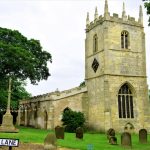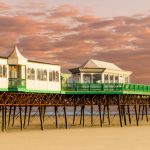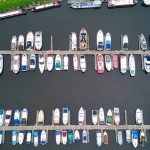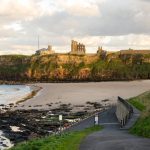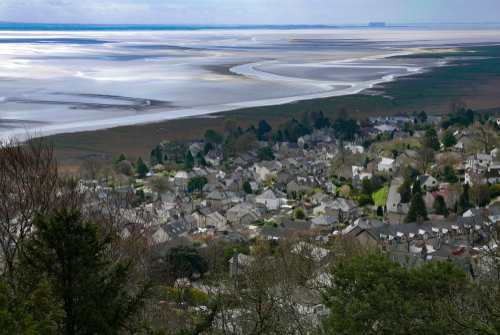
Grange over Sands is a town and civil parish located on the north side of Morecambe Bay in Cumbria, northwest England. The town is located 13 miles (21 km) to the south of Kendal, 25 miles (40 km) east of Barrow-in-Furness and 28 miles (45 km) west of Lancaster. Historically part of Lancashire, since 1974, the town has been administered as part of the South Lakeland district of Cumbria. In the 2011 UK Census Grange-over-Sands had a recorded population of 4,114.
Go to the Cumbria Business Directory
Grange over Sands – A Fleeting History
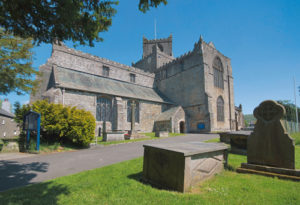
Cartmel Priory was founded in 1187. Editorial Credit HAL-9000 / Shutterstock.com
The first known settlers in the Grange area were the monks at Cartmel. Since, in 1189, William Marshal, the 1st Earl of Pembroke, founded Cartmel Priory. The Priory was largely saved from destruction during the 16th-century ‘Dissolution of the Monasteries’ since Cartmel’s villagers strongly protested that the Abbey was, in fact, their parish church.
The first written reference to the settlement of ‘Grange’ is recorded in the ancient Cartmel Priory Registers of 1536 when it was recorded as ‘Grange-with-Kentisbank’. Grange was a place where it was known that the monks from Cartmel Priory stored some of their grain. Thus, it is believed that the village’s designation is derived from an Old French word ‘graunge’, which meant ‘barn’ or ‘granary’. An alternative school of thought is that the name may be derived from the Latin ‘grancia’, meaning grain.
Grange initially developed slowly as a small fishing village. By the 18th century, its tiny port facilities were handling freight from ships that were too large to navigate the shallow waters of the Kent estuary. Thus, the cargo was unloaded at Grange and stored in warehouses. Later, it was transported upriver to its final destination by smaller vessels. A ‘Tide Waiter’ was duly appointed to Grange, who was in essence responsible for carrying out custom duties.
The 1800s
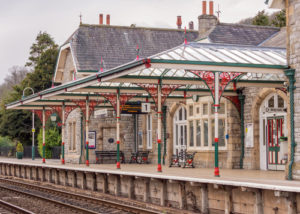
The town’s Grade II Listed Railway Station dates back to 1857. Editorial Credit: Sue Burton Photography/Shutterstock.com
In 1820, a new turnpike road was completed between Levens Bridge and Greenodd of Morecambe Bay, greatly improving Grange’s local connectivity. However, the much shorter cross-sand (and free) routes across Morecambe Bay, remained popular with locals. In the 1820s, Grange was described by one visitor as a ‘beautiful sea-bathing village’. By this time, the town had several villas and hotels that were catering for a select band of tourists.
However, it was during the Victorian era that the town’s principal development took place, particularly after the Ulverston and Lancaster Railway was completed in 1857. This enabled easy access to the town by visitors, greatly assisting its transformation in becoming a popular seaside resort. More hotels were built to meet increasing demand and piers were constructed at the end of Bailey Lane and Clare House Lane to accommodate the steamers arriving from Morecambe and Blackpool. In addition, the nouveau rich factory owners from Lancashire and Yorkshire, who could now reach Grange in a couple of hours, began to build holiday homes in the town.
In 1858, the Reverend Wilson Rigg, the new vicar of St Paul’s Church, took exception to much of his mail being sent to Grange in Borrowdale. He decided to add the ‘over-Sands’ suffix to his address, to distinguish between the two places. The name soon became the norm and has stuck ever since.
In 1874, the Grange formed its own Local Board of Health (LBD), which gave the town control over its own sewers, water supply, road maintenance and street cleaning. The 1894 Local Government Act saw the LBDs scrapped, to be replaced with Urban District Councils. The newly formed Grange Urban District Council covered 1540 acres (623 ha.), with a further 274 acres (111 ha.) being added in 1914.
In the Edwardian era, Grange was dubbed by some as the “Torquay of the North”. The new promenade was opened in 1904 and later extended to over a mile long in length. The town’s Ornamental Gardens were also constructed on an old salt marsh. In 1932, Grange Lido was built along the seafront. The building remained in use for more than 60 years, before closing in 1993.
Grange over Sands – The Modern Era
The 1974 local government re-organisation saw the disbanding of Grange’s Urban District Council. A portion of North Lancashire, which included Grange-Over-Sands, went to form the new county of Cumbria. Grange Town Council was formed, falling under the jurisdiction of South Lakeland District Council’s administration
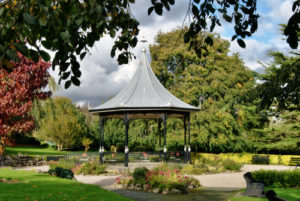
Bandstand at the Ornamental Gardens
In 2011, Grange Lido was granted Grade II listed status by National Heritage. In 2019, the derelict building was opened for public tours. It was later announced that there were plans to refurbish the building and reopen it to the public, though not as a Lido.
In the last 20-30 years, the course of the River Kent, which used to flow past the promenade has migrated southwards, away from the town. Thus, the old riverbed has now silted-up and the area has grassed over and is regularly grazed by small flocks of sheep. There have been recent signs that the river was beginning to switch back across the Bay to nearer to its former course and closer to Grange. Whether in time the river once again flows past the promenade, remains to be seen.
Grange is viewed as a good centre for tourists who want to explore the South Lakes. It’s home to a good number of hotels, bed & breakfasts and holiday properties. The town’s main central features are its ornamental gardens duck and a traffic-free promenade. Grange’s Town Council provides a tourist information service which is based on the ground floor of the Victoria Hall in Main Street.
Getting To Grange over Sands
By Road
It’s easy to get to Grange over Sands by road. Turn off the M6 at Junction 36 and head along the A590 towards Barrow-in-Furness for about 10 miles, then take the B5277.
By Train
Grange over Sands railway station lies on the Furness Line, which runs from Barrow-in-Furness to Lancaster. Barrow is also a terminus station on the Cumbrian Coast Line which connects with multiple towns and villages through to Carlisle. Carlisle and Lancaster both lie on the West Coast Main Line (WCML) which enables direct travel to many destinations in all parts of the country.
By Bus
If you want to get to Grange by bus then you can take a National Express from many major UK destinations to Kendal. The town is connected to Kendal by the X6 bus service, which runs to Ulverston. The journey time is around about 40 mins.
By Air
Manchester Airport is the nearest airport, about a 1 hr 30 minutes journey time by car (See above; By Road).
Morecambe Bay
Morecambe Bay stretches from the south-west coast of Cumbria to Fleetwood in Lancashire, with the like of the coastal towns of Grange-over-Sands, Morecambe and Heysham, scattered along its shoreline. The Leven, Kent, Keer, Lune and Wyre rivers all drain into Morecambe Bay, where their estuaries have formed a number of peninsulas. Much of the land around the bay is reclaimed, forming salt marshes used in agriculture. The Bay is also an important wildlife sanctuary, having abundant birdlife and varied marine habitats, with a bird observatory at Walney Island. Morecambe Bay is also particularly famed for its fertile cockle beds, which local fishermen have been able to take advantage of for generations.
Seven Islands
There are seven islands of note in the bay, all to the north; i.e. Walney, Barrow, Sheep, Piel, Chapel, Foulney and Roa. Walney Island, in the north-western corner of the Bay, is substantially larger than all the others. Sheep, Piel, Chapel and Foulney Islands are all tidal and some can be walked to at low tide across the sands with the appropriate care and local guidance. Roa Island is linked to the mainland by a causeway, while Barrow Island has been connected to the mainland for many years as part of the extensive docklands development at Barrow-in-Furness.
The Bay is recognised as one of the best places in the UK for many adrenalin-fuelled activities such as sailing, powered paragliding, parachuting, windsurfing, mountain biking, horseriding, and kitesurfing. It also has some of the most scenic coastlines around Britain and there a number of recognised long-distance walks and cycle routes that start in the area. These include the; ‘Way of the Roses’, a cycle route that traverses the country across to Bridlington Bay, and the ‘Lancashire Coastal Way’.
A reminder to anyone that may need it, if visiting the area; the Bay is notorious for its quicksand and fast-moving tides! On the infamous night of 5 February 2004, at least 21 unsuspecting Chinese immigrant cockle pickers were drowned after being cut off by the incoming tides. No one should attempt to walk within the tidal range of the Bay without proper local guidance.
There has been a royal appointed, local ‘Queen’s Guide to the Sands’, since the 16th century, who is ultimately responsible for the supervision of safe crossings of the Bay. The popular 8 or 9 mile guided walks take place between May and September each year, with the times varying, depending on the tides.
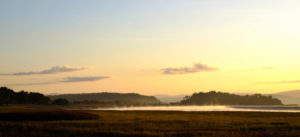
A view of Morecambe Bay from the pier at Grange-over-Sands
A Notable Son
Edmund Law was born on 6 June 1703 in Grange-over-Sands. He became a noted priest in the Church of England. He served as Master of Peterhouse and Knightbridge Professor of Philosophy at the University of Cambridge from 1764 to 1769. He then went on to become Bishop, and later Archdeacon, of Carlisle. Law died at Rose Castle, in Dalston, near Carlisle, on 14 August 1787, and was buried in Carlisle Cathedral.
Things to see and do in Grange over Sands!
Hampsfell Hospice –
Is a robust limestone rubble tower that was built in 1846. Commissioned by the vicar of Cartmel as a resting place for travellers, the tower is situated on Hampsfield Fell. Above the entrance, there are two words in Greek; RODODAKTYLOS EOS which translates as “rosy-fingered dawn” – a quotation often used by Homer. You can also access the tower’s roof from an outdoor staircase from where there are some great views.
Cartmel Races –
just 2.5 miles from Grange, Cartmel racecourse is set in wooded parkland. It stages regular meetings throughout the May to August, National Hunt season. Because of its superb setting and informal nature, it’s a popular venue, attracting some of the biggest crowds in the country for a steeplechase event. There’s also a good selection of shops and food outlets at the course, as well as fairground style entertainment. A great place for both family and friends to socialise.
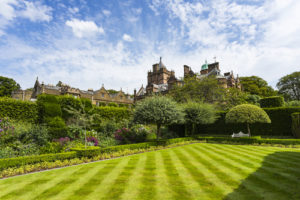
Holker Hall and its award-winning gardens
Holker Hall –
is a stately home about 5 miles from Grange. It’s the home of the Cavendish Family, who have owned it throughout its 400-year history. The Hall is famed for its magnificent grounds, which consist of 25 acres of formal and woodland gardens, with decorative water features. In 1996, the grounds were voted “amongst the best in the world” by the Good Gardens Guide. There’s also a gift shop, food hall, café, restaurant, a small children’s playground and picnic tables. A timetable of regular events runs through the year.
Cartmel Priory –
dating from the 12th century, the Priory has many unique architectural features. For instance, the square belfry tower constructed diagonally across the original tower is the only one like it in the UK. And, there’s a large 15th-century stained glass window, that almost fills the east wall. There’s also a strong tradition of musical worship and bell ringing at the Priory that goes back centuries. Opening times; 9:00 am to 5:30 pm Monday to Saturday, 4.30 pm on Sunday, 9.00 am to 3:30 pm during Winter.
Where to stay in Grange over Sands?
There is a decent amount of available accommodation in and around Grange, especially given the size of the town. The main type of available accommodation is either guesthouse, B&B, or a small hotel. Typically, prices range from £70 to £120, per night, for 2 adults sharing. Holiday apartments are also available for those travelling in larger groups.
The Grange Over Sands Quiz
